The Partscaster Thread
Discussion
I notice there’s no Partscaster thread on here so I thought I’d start one. I case you don’t know what a Partscaster is, I suppose one definition might be – “a guitar consisting of parts that did not leave the factory together,” or similar. And there are so many people out there selling really nice parts, that it would be a crying shame not to buy them and turn them into working instruments again.
I want to see yours, but first, I’ll start the ball rolling with some of mine.
First up, these two Mexican Classic Strats.
I saw this Classic 60’s on eBay and just had to have it. Shell Pink was the rarest Fender Custom Color originally (only in the catalogue from 1960 to 63, when Candy Apple Red replaced it) and is not that prolific on reissues either.
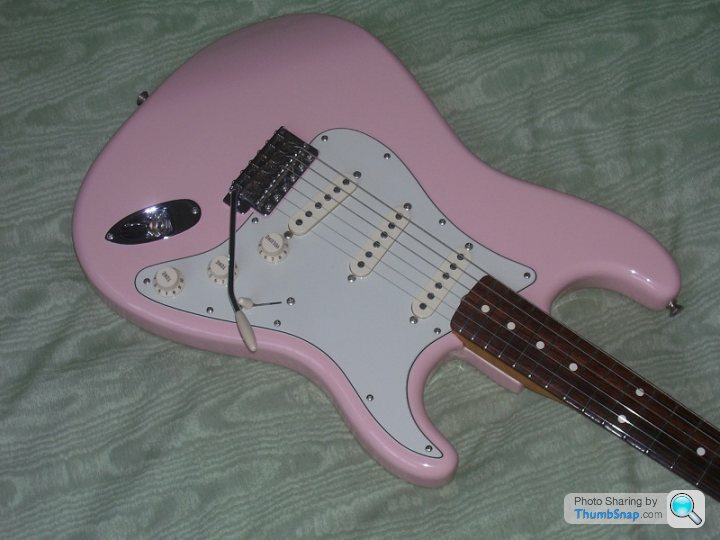
Then a couple of months later this Classic 50’s in Fiesta Red came up, and again I pressed the trigger.
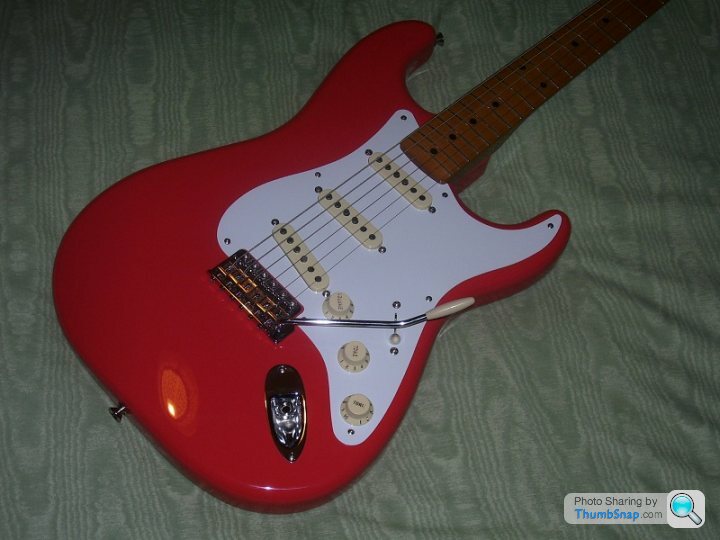
Then I had a thought. I’ve had several 50’s Strats in Fiesta Red (these are quite common; probably the Hank Marvin influence), but never a 60’s one. Fender never did a Mexican one, the Japanese ones are as rare as hen’s teeth, and the US ones out of my price range. Just a minute, I thought, I’ve got a 60’s Strat … why not just swap bodies?
So to cut a long story short – I did! The maple neck looked absolutely drop-dead gorgeous on the pink one.
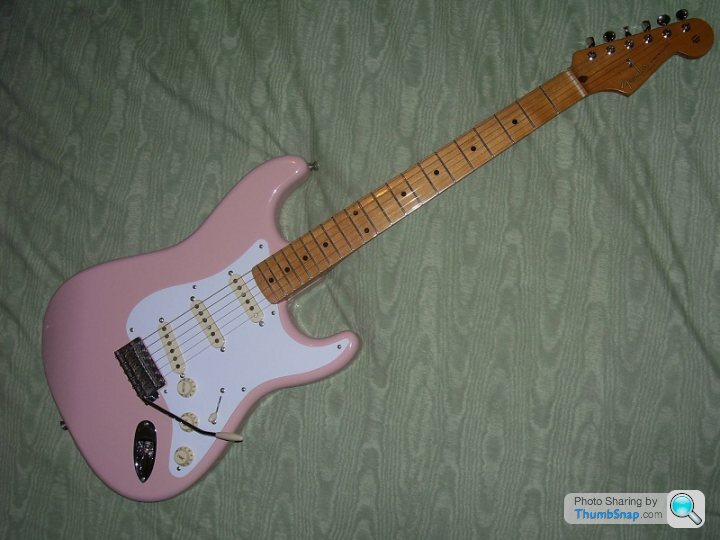
Unfortunately, a spell of poverty meant I had to have another of those culls that afflict me from time to time, so the pink one had to go. I managed to hang on to the red one, though, and have it to this day.
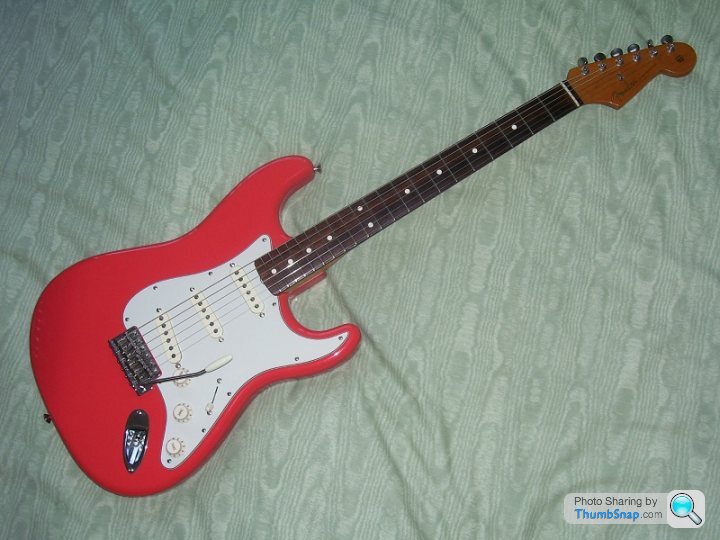
This is still my favourite guitar and sounds magnificent – although the fact that I have since fitted Fender 57/62 pickups, Callaham steel trem block and 12-52 strings may have something to do with that.
OK moving forward a little in time and things improved so I was able once more to indulge my hobby. My two MIM Classics had whetted my appetite (opened the floodgates more like).
From a US seller on eBay called The Stratosphere I bought a fully loaded Deluxe Players Strat body, in a rather fetching Crimson Red Transparent; from another eBay seller called ilovesmesomestrats came a Deluxe neck. Here they are, just after assembly and stringing up.
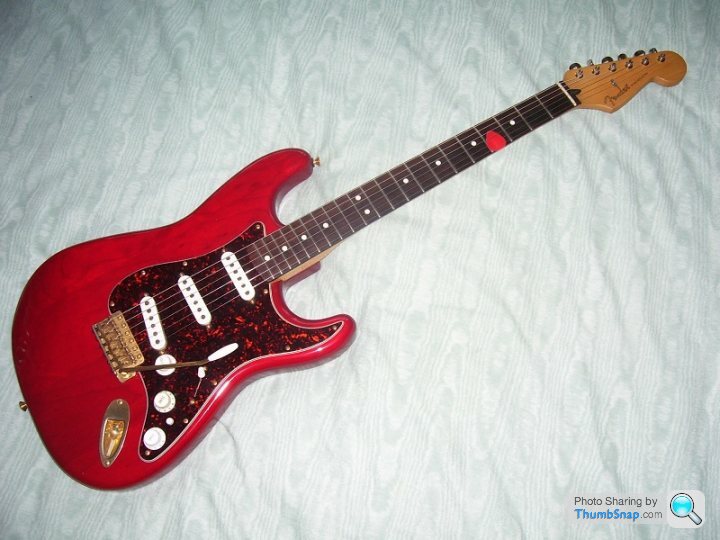
They didn’t stay together for long, though, and the body and neck went in different directions. Back to Stratosphere again, this time for a fully loaded Classic 70’s in Olympic White. I don’t seem to have a photo of this one as it arrived, but this is how it ended up, with a new tortoiseshell scratchplate plus new pickups and circuitry.

I then bought a Mighty Mite neck for the red one, this was a CBS-style one with the larger headstock (I just fancied a change). A black scratchplate complete with new pickups and all black plastic parts completed the late 70’s look. Pickups were wired in series so this became my Brian May Strat!
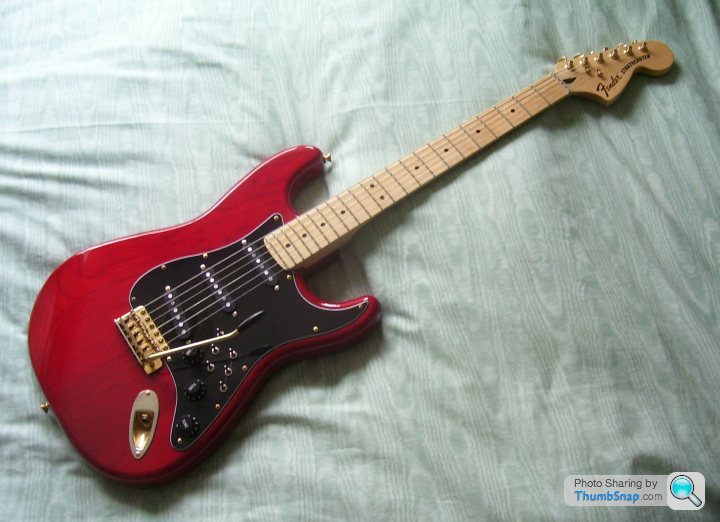
Later when my finances got worse and another cull was in the offing, both guitars got sold. The red one had the Brian May scratchplate removed and sold, to be replaced by the original white plate from the Oly White one. Thus becoming an early 70’s Strat.
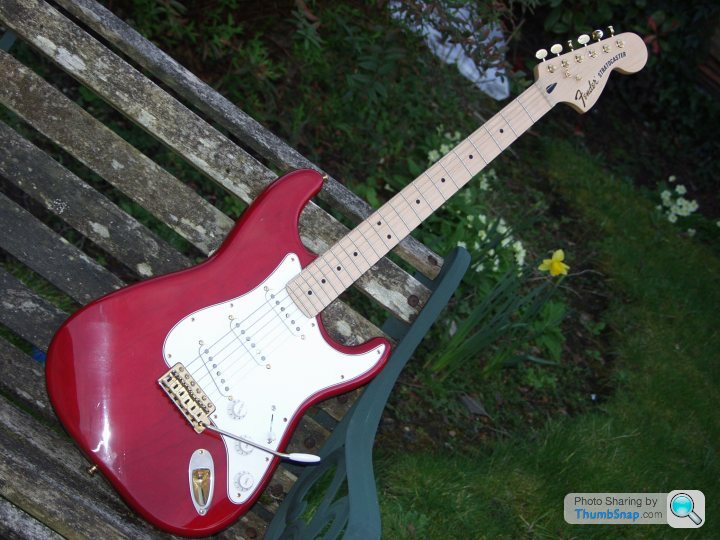
The original torty plate from the red one went on the white body (thus it retained its identity as an early 60’s reissue), my new one being removed and kept (and I’ve still got that; I wasn’t going to let my clever circuitry go to waste). I don’t have a photo of the guitar in this guise but it would have looked the same as before anyway.
I did more recently buy a cheap Chinese fake Strat to take the torty plate with the clever circuitry, but then decided it was deserving of something a little better so the guitar’s up for sale. When I can afford to, though, I will buy something decent to put it on.
Right, back to an earlier era now; all these are from about 10 years ago. First off, Candy Apple Red with pearloid scratchplate. Don’t remember much about it except the only genuine Fender parts on it were the pickups. It originally had a Fender decal on the head, but I removed it before sale.
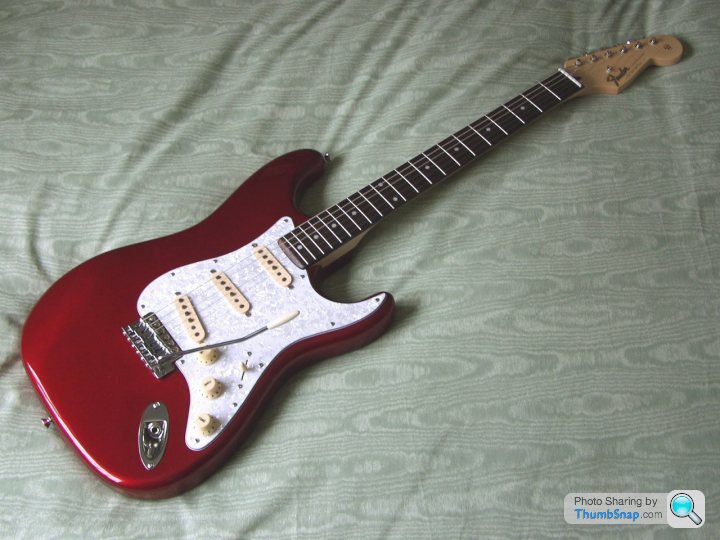
Next, Squier in Fiesta Red with matching headstock; matching the colour was fun I seem to recall. This one did have a Fender decal, but it’s a bit difficult to see in the photo.
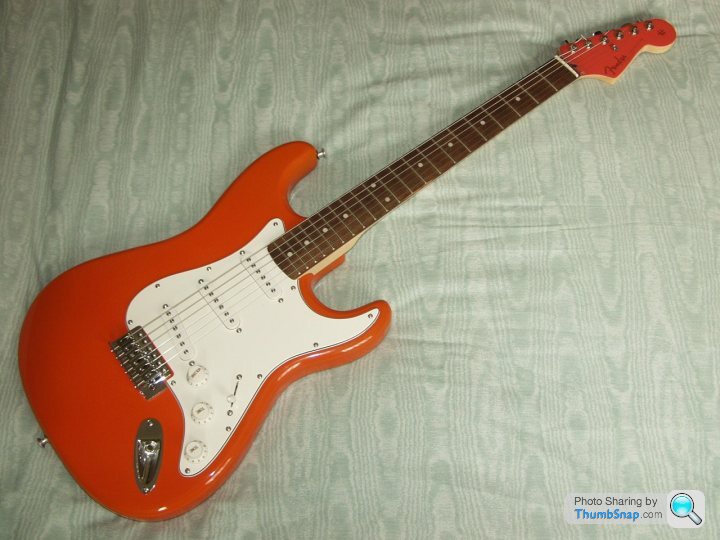
Telecaster – this was a lovely guitar which absolutely refused to sell – it went in parts in the end. Neck was a Mighty Mite one – licensed by Fender – and the body was absolutely heavenly; colour and grain to die for! Pickups and scratchplate were genuine Fender but I don’t think anything else was.
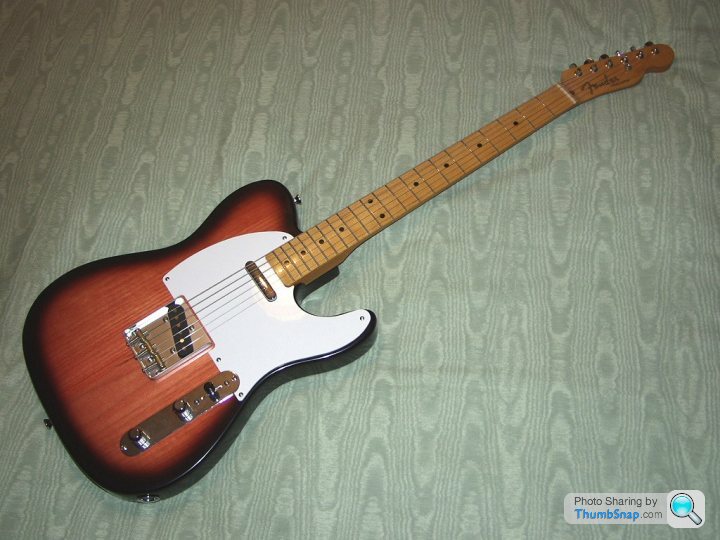
Last but not least, the very first! This was based around a mahogany Strat body Geoff Gale built for me, and an old neck I’d had lying around for ages – it had been on a VOX for many years, replacing the original which had warped. It had an anodised aluminium scratchplate and the pickups were DiMarzios.
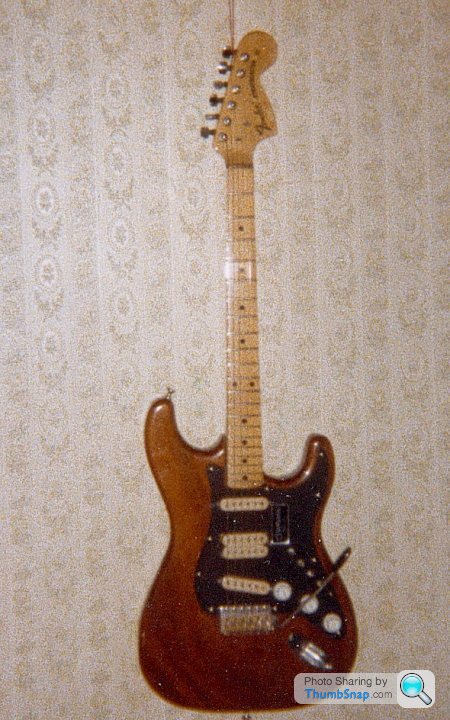
Bit of a strange configuration with the humbucker in the middle you might say. Well you see, I had long been impressed with the guitar sound of John Lees from Barclay James Harvest, whose Strat had a Gibson pickup between the neck and middle pickups. So my Strat had the middle pickup replaced with humbucker. I didn’t realise at the time that the correct place to put a humbucker on a Strat was in the bridge position, as nobody had thought of doing that then. (This was in 1979.)
Switches were on/off and phase for each pickup, plus a series/parallel switch for the Dual sound Humbucker. I tried several permutations of tone and volume controls, ending up with a volume control for each pickup. I think.

It can be heard being played here (the lead sound is the humbucker only):
https://www.youtube.com/watch?v=hovzmIqwsVU&fe...
(Sorry about the dreadful sound quality.)
The next pic shows me taking the guitar to bits again about 3 years later; noticed I’d changed the neck by then. The next time you see it, I’ve changed everything! I was about to join Tangent (a Shadows tribute band at a time when the phrase ‘tribute band’ hadn’t even been thought of), so everything went back to standard Strat configuration, and I took the body into the garage and sprayed it Fiesta Red, or as close as I could get to it anyway.
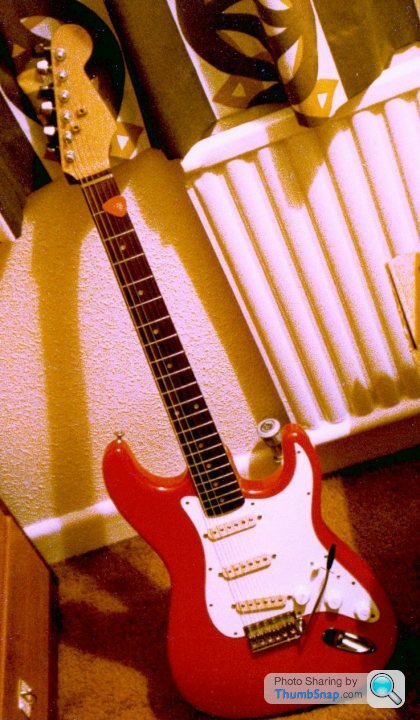
(Notice it has a rosewood neck, which is where we came in!) A couple of years later, I had it resprayed Sonic Blue, but I don’t have a photo of that.
TO BE CONTINUED …
But I want to see some of yours first!
I want to see yours, but first, I’ll start the ball rolling with some of mine.
First up, these two Mexican Classic Strats.
I saw this Classic 60’s on eBay and just had to have it. Shell Pink was the rarest Fender Custom Color originally (only in the catalogue from 1960 to 63, when Candy Apple Red replaced it) and is not that prolific on reissues either.

Then a couple of months later this Classic 50’s in Fiesta Red came up, and again I pressed the trigger.

Then I had a thought. I’ve had several 50’s Strats in Fiesta Red (these are quite common; probably the Hank Marvin influence), but never a 60’s one. Fender never did a Mexican one, the Japanese ones are as rare as hen’s teeth, and the US ones out of my price range. Just a minute, I thought, I’ve got a 60’s Strat … why not just swap bodies?
So to cut a long story short – I did! The maple neck looked absolutely drop-dead gorgeous on the pink one.

Unfortunately, a spell of poverty meant I had to have another of those culls that afflict me from time to time, so the pink one had to go. I managed to hang on to the red one, though, and have it to this day.

This is still my favourite guitar and sounds magnificent – although the fact that I have since fitted Fender 57/62 pickups, Callaham steel trem block and 12-52 strings may have something to do with that.
OK moving forward a little in time and things improved so I was able once more to indulge my hobby. My two MIM Classics had whetted my appetite (opened the floodgates more like).
From a US seller on eBay called The Stratosphere I bought a fully loaded Deluxe Players Strat body, in a rather fetching Crimson Red Transparent; from another eBay seller called ilovesmesomestrats came a Deluxe neck. Here they are, just after assembly and stringing up.

They didn’t stay together for long, though, and the body and neck went in different directions. Back to Stratosphere again, this time for a fully loaded Classic 70’s in Olympic White. I don’t seem to have a photo of this one as it arrived, but this is how it ended up, with a new tortoiseshell scratchplate plus new pickups and circuitry.

I then bought a Mighty Mite neck for the red one, this was a CBS-style one with the larger headstock (I just fancied a change). A black scratchplate complete with new pickups and all black plastic parts completed the late 70’s look. Pickups were wired in series so this became my Brian May Strat!

Later when my finances got worse and another cull was in the offing, both guitars got sold. The red one had the Brian May scratchplate removed and sold, to be replaced by the original white plate from the Oly White one. Thus becoming an early 70’s Strat.

The original torty plate from the red one went on the white body (thus it retained its identity as an early 60’s reissue), my new one being removed and kept (and I’ve still got that; I wasn’t going to let my clever circuitry go to waste). I don’t have a photo of the guitar in this guise but it would have looked the same as before anyway.
I did more recently buy a cheap Chinese fake Strat to take the torty plate with the clever circuitry, but then decided it was deserving of something a little better so the guitar’s up for sale. When I can afford to, though, I will buy something decent to put it on.
Right, back to an earlier era now; all these are from about 10 years ago. First off, Candy Apple Red with pearloid scratchplate. Don’t remember much about it except the only genuine Fender parts on it were the pickups. It originally had a Fender decal on the head, but I removed it before sale.

Next, Squier in Fiesta Red with matching headstock; matching the colour was fun I seem to recall. This one did have a Fender decal, but it’s a bit difficult to see in the photo.

Telecaster – this was a lovely guitar which absolutely refused to sell – it went in parts in the end. Neck was a Mighty Mite one – licensed by Fender – and the body was absolutely heavenly; colour and grain to die for! Pickups and scratchplate were genuine Fender but I don’t think anything else was.

Last but not least, the very first! This was based around a mahogany Strat body Geoff Gale built for me, and an old neck I’d had lying around for ages – it had been on a VOX for many years, replacing the original which had warped. It had an anodised aluminium scratchplate and the pickups were DiMarzios.

Bit of a strange configuration with the humbucker in the middle you might say. Well you see, I had long been impressed with the guitar sound of John Lees from Barclay James Harvest, whose Strat had a Gibson pickup between the neck and middle pickups. So my Strat had the middle pickup replaced with humbucker. I didn’t realise at the time that the correct place to put a humbucker on a Strat was in the bridge position, as nobody had thought of doing that then. (This was in 1979.)
Switches were on/off and phase for each pickup, plus a series/parallel switch for the Dual sound Humbucker. I tried several permutations of tone and volume controls, ending up with a volume control for each pickup. I think.

It can be heard being played here (the lead sound is the humbucker only):
https://www.youtube.com/watch?v=hovzmIqwsVU&fe...
(Sorry about the dreadful sound quality.)
The next pic shows me taking the guitar to bits again about 3 years later; noticed I’d changed the neck by then. The next time you see it, I’ve changed everything! I was about to join Tangent (a Shadows tribute band at a time when the phrase ‘tribute band’ hadn’t even been thought of), so everything went back to standard Strat configuration, and I took the body into the garage and sprayed it Fiesta Red, or as close as I could get to it anyway.

(Notice it has a rosewood neck, which is where we came in!) A couple of years later, I had it resprayed Sonic Blue, but I don’t have a photo of that.
TO BE CONTINUED …
But I want to see some of yours first!
singlecoil said:
... There are complete matched kits you can get ...
True, I recently came across this:http://www.ebay.co.uk/itm/231393657040?_trksid=p20...
They do them in gold and black too.
Here’s another recent project, a Chinese fake Fender Strat. This is actually a fantastic guitar – everyone who plays it loves it! I bought it for my tortoiseshell scratchplate, the one with all the clever circuitry on, then decided it needed a better guitar, so have now put the scratchplate aside until I can afford a real Fender, and the guitar's up for sale as part of my latest cull.
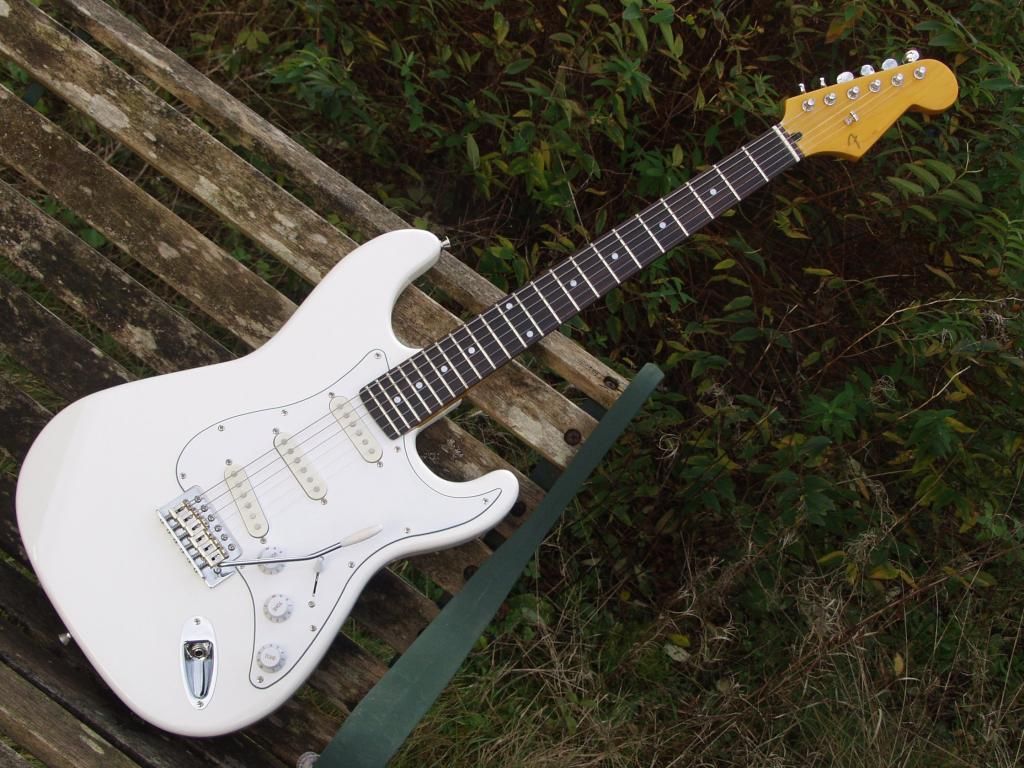
It’s in 60’s style so has a rosewood neck (with 22 frets in this case!) and 3-ply scratchplate held on by 11 screws. The tuners were fairly basic diecasts so I replaced them with these vintage-style ones. I then removed the neck and enlarged the mounting holes in the body. This is a job that frequently has to be done; the screws MUST pass through the body without gripping it – they should grip the neck ONLY, or it will never be held on properly. (I notice most new guitars need this, regardless of who made them.)
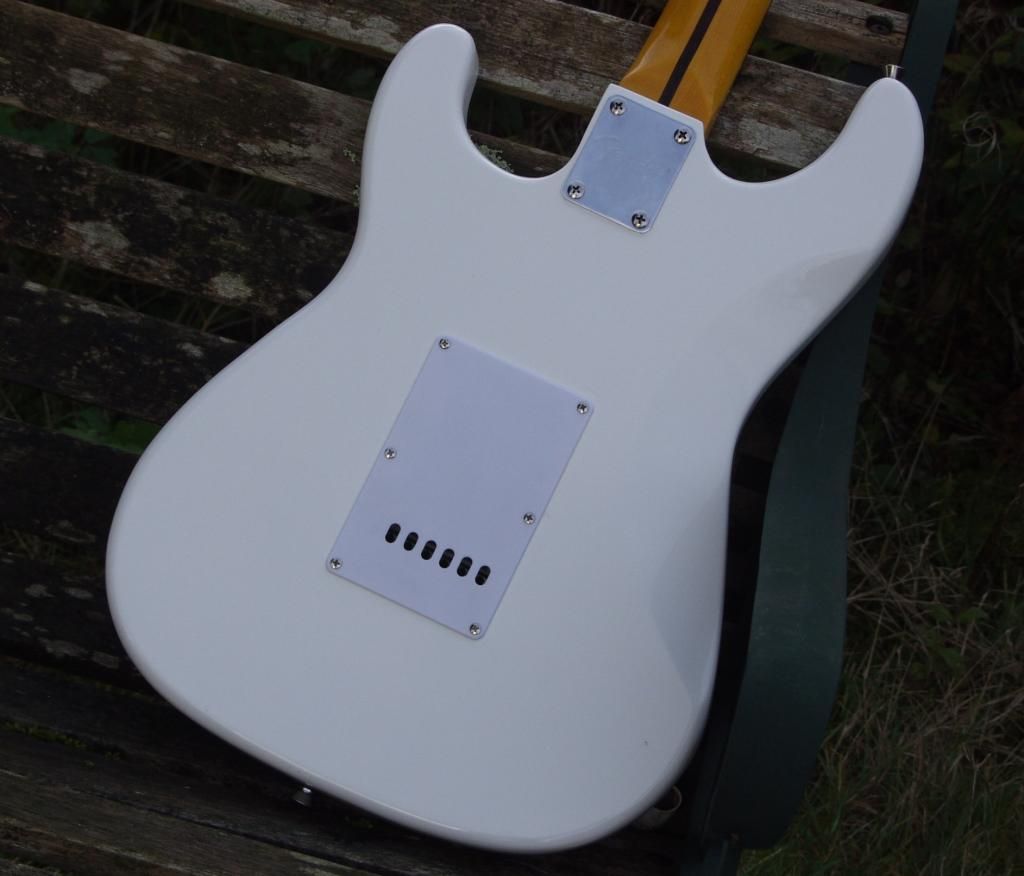
The scratchplate, complete with all controls and plastic parts, came from a Squier (replacing a flimsy pearloid one with very anaemic-looking white parts). Cast bridge saddles were thrown away and replaced by the period-correct steel ones with FENDER stamped on them. Pickups have been changed; I’ve no idea what these are, but I know they sound great! Finally, while the neck was off I levelled and reprofiled the frets and when it was reattached and the strings on, I also recut the nut (this is often too high even on quite expensive guitars). Relief, action and intonation have also been set up correctly. Strings are 10-46.
It does have an authentic 60’s-style logo on the head, together with a serial number on the back to say it was built in the USA in 2012 (it wasn’t!). As these photos are also on eBay, I edited these out, plus the ones on the headstock and neckplate, to avoid falling foul of the dreaded eBay Thought Police.
It even comes with a case, a tweed one with Fender on it!

It’s in 60’s style so has a rosewood neck (with 22 frets in this case!) and 3-ply scratchplate held on by 11 screws. The tuners were fairly basic diecasts so I replaced them with these vintage-style ones. I then removed the neck and enlarged the mounting holes in the body. This is a job that frequently has to be done; the screws MUST pass through the body without gripping it – they should grip the neck ONLY, or it will never be held on properly. (I notice most new guitars need this, regardless of who made them.)

The scratchplate, complete with all controls and plastic parts, came from a Squier (replacing a flimsy pearloid one with very anaemic-looking white parts). Cast bridge saddles were thrown away and replaced by the period-correct steel ones with FENDER stamped on them. Pickups have been changed; I’ve no idea what these are, but I know they sound great! Finally, while the neck was off I levelled and reprofiled the frets and when it was reattached and the strings on, I also recut the nut (this is often too high even on quite expensive guitars). Relief, action and intonation have also been set up correctly. Strings are 10-46.
It does have an authentic 60’s-style logo on the head, together with a serial number on the back to say it was built in the USA in 2012 (it wasn’t!). As these photos are also on eBay, I edited these out, plus the ones on the headstock and neckplate, to avoid falling foul of the dreaded eBay Thought Police.
It even comes with a case, a tweed one with Fender on it!
Edited by Evangelion on Friday 19th December 00:05
Edited by Evangelion on Friday 19th December 00:16
Can't remember where I got this but it's bloody useful - the Jerry Donahue tuning method for three-saddle Telecasters:
Saddle Up Your Telecaster® - By Jerry Donahue
We asked "Bendmaster of the Telecaster" Jerry Donahue to share some of his secrets for setting up a Telecaster® bridge and keeping it properly intonated (Jerry demonstrates this technique in his clinics).
“Attention all current and would-be Tele® slingers! You needn't resort to six individual bridge saddles to improve your intonation. The original Broadcaster design called for three brass saddles: and that's still the best design today. The larger saddles mean more mass, providing greater output, sustain and tone. Also, with two strings per saddle, you have twice the string pressure against the body! [Editor's note: The Fender® Custom Shop Jerry Donahue model and "JD" Tele® use the three vintage brass saddles].
Now, on to intonation: Until fairly recently, I felt that a guitar couldn't really play in tune unless each string's 12th fret harmonic and 12th fret note had the exact same reading on the electric tuner. And of course, they never do on a three-saddle bridge. I finally settled on a technique that not only deals with this problem but, to my delight, addresses other inherent problems also. Here it is: Adjust the middle saddle's intonation screw so that the "D" string's 12th fret note reads slightly flat of the 12th fret harmonic on your tuner. Then, check out the "G" string's 12th fretted note. This note should be only MARGINALLY sharp of the harmonic. Are you with me? Now tune your guitar, with the open "G" string reading somewhere between A440 and A439 (so that the 12th FRETTED note is at A440). Tune the other strings as one would normally. Final adjusments can be made by ear when you compare first position E major and E minor chords. The E major's G# note (third string, 1st fret) should no longer seem sharp in the chord; and the open "G" string should still be perceptively in tune within the E minor chord.
Here's another for instance: An "A" chord barred at the fifth fret sounds fine. But when the nearest "E" is played (5th string, 7th fret/ 4th string, 6th fret/ 3rd string, 4th fret/ 2nd string, 5th fret), it typically sounds "off." The major third is the culprit (4th string, 6th fret): it typically sounds sharp. But with my adjus™ent (the 4th string's 12th fretted note being slightly flat) the problem no longer exists. There is a small margin of error here, which actually works to the guitarist's advantage!
OCCASIONALLY, depending on the gauge of your strings and the force of your picking hand, it might also serve you to marginally flatten the low E string. I do this as I use a 42 and like to hit it fairly hard sometimes. Trust your own ears, though, as each instrument tends to be different, too.
A final qualification in adopting all the aforementioned technique: A piano tuner may use an electronic tuner as a point of reference. But if he tuned the entire keyboard to be "perfect", it would sound awful. The bottom keys actually must be tuned sharp and the high ones tuned flat. This is the only way the human brain will perceive the piano to be in tune. It's essentially the same concept I've applied here to the Telecaster®. I really like this method. Once I adopted it, my Tele's® sounded noticeably more in tune than my Strats® (across all of the chord shapes) ... so I've since made the same adjustments to the Strats®!!
Remember, life is about compromise. Check it out!" - Jerry Donahue
Saddle Up Your Telecaster® - By Jerry Donahue
We asked "Bendmaster of the Telecaster" Jerry Donahue to share some of his secrets for setting up a Telecaster® bridge and keeping it properly intonated (Jerry demonstrates this technique in his clinics).
“Attention all current and would-be Tele® slingers! You needn't resort to six individual bridge saddles to improve your intonation. The original Broadcaster design called for three brass saddles: and that's still the best design today. The larger saddles mean more mass, providing greater output, sustain and tone. Also, with two strings per saddle, you have twice the string pressure against the body! [Editor's note: The Fender® Custom Shop Jerry Donahue model and "JD" Tele® use the three vintage brass saddles].
Now, on to intonation: Until fairly recently, I felt that a guitar couldn't really play in tune unless each string's 12th fret harmonic and 12th fret note had the exact same reading on the electric tuner. And of course, they never do on a three-saddle bridge. I finally settled on a technique that not only deals with this problem but, to my delight, addresses other inherent problems also. Here it is: Adjust the middle saddle's intonation screw so that the "D" string's 12th fret note reads slightly flat of the 12th fret harmonic on your tuner. Then, check out the "G" string's 12th fretted note. This note should be only MARGINALLY sharp of the harmonic. Are you with me? Now tune your guitar, with the open "G" string reading somewhere between A440 and A439 (so that the 12th FRETTED note is at A440). Tune the other strings as one would normally. Final adjusments can be made by ear when you compare first position E major and E minor chords. The E major's G# note (third string, 1st fret) should no longer seem sharp in the chord; and the open "G" string should still be perceptively in tune within the E minor chord.
Here's another for instance: An "A" chord barred at the fifth fret sounds fine. But when the nearest "E" is played (5th string, 7th fret/ 4th string, 6th fret/ 3rd string, 4th fret/ 2nd string, 5th fret), it typically sounds "off." The major third is the culprit (4th string, 6th fret): it typically sounds sharp. But with my adjus™ent (the 4th string's 12th fretted note being slightly flat) the problem no longer exists. There is a small margin of error here, which actually works to the guitarist's advantage!
OCCASIONALLY, depending on the gauge of your strings and the force of your picking hand, it might also serve you to marginally flatten the low E string. I do this as I use a 42 and like to hit it fairly hard sometimes. Trust your own ears, though, as each instrument tends to be different, too.
A final qualification in adopting all the aforementioned technique: A piano tuner may use an electronic tuner as a point of reference. But if he tuned the entire keyboard to be "perfect", it would sound awful. The bottom keys actually must be tuned sharp and the high ones tuned flat. This is the only way the human brain will perceive the piano to be in tune. It's essentially the same concept I've applied here to the Telecaster®. I really like this method. Once I adopted it, my Tele's® sounded noticeably more in tune than my Strats® (across all of the chord shapes) ... so I've since made the same adjustments to the Strats®!!
Remember, life is about compromise. Check it out!" - Jerry Donahue
Gassing Station | Music | Top of Page | What's New | My Stuff



